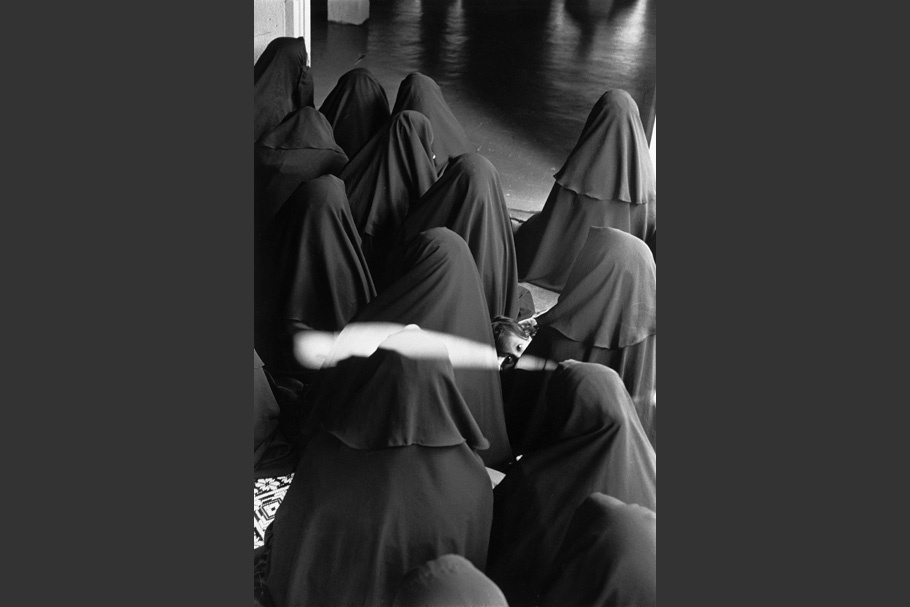20020409-abbas-mw06-collection-001

Jakarta, Indonesia.
Friday prayer at a women’s college.
20020409-abbas-mw06-collection-002

Tehran, Iran.
Armed militants in front of the U.S. embassy where diplomats are held hostage.
20020409-abbas-mw06-collection-003

Tehran, Iran.
First anniversary of the revolution.
20020409-abbas-mw06-collection-004

Afghanistan.
Sentinel of the Hizb-e-Islam faction on the road to Kabul.
20020409-abbas-mw06-collection-005

Algiers, Algeria.
Young unemployed men called hitists, "those who prop up the wall."
20020409-abbas-mw06-collection-006

Algiers, Algeria.
20020409-abbas-mw06-collection-007

Alexandria, Egypt.
20020409-abbas-mw06-collection-008

Algiers, Algeria.
Young unemployed men called hitists, "those who prop up the wall."
20020409-abbas-mw06-collection-009

Arafat, Saudi Arabia.
Pilgrims perform Hajj.
20020409-abbas-mw06-collection-010

Arafat, Saudi Arabia.
Pilgrims perform Hajj.
20020409-abbas-mw06-collection-011

Multan, Pakistan.
Pilgrims to the Sheik Bahauddin Zakariya shrine.
20020409-abbas-mw06-collection-012

Severi, Mali.
20020409-abbas-mw06-collection-013

Ipoh, Malaysia.
Koranic class attended by children of the fundamentalist sect al-Arqam.
20020409-abbas-mw06-collection-014

Diourbel, Senegal.
Koranic school. Verses from the Koran are written on wood boards to be memorized by rote.
20020409-abbas-mw06-collection-015

Baku, Azerbaijan.
Ritual of Ashura.
20020409-abbas-mw06-collection-016

Karachi, Pakistan.
The Shi’ite community celebrates Ashura.
20020409-abbas-mw06-collection-017

Cairo, Egypt.
Al Azhar mosque. A muslim prays. 1987.
20020409-abbas-mw06-collection-018

Batley, Great Britain.
Zakaria Muslim Girls High School.
20020409-abbas-mw06-collection-019

Kabul, Afghanistan.
The groom, an emigrant to Europe, is present only as a photo.
20020409-abbas-mw06-collection-020

Qom, Iran.
Ayatollah Khomeiny.
20020409-abbas-mw06-collection-021

Cairo, Egypt.
Biology lab at Cairo University.
20020409-abbas-mw06-collection-022

Jdida, Morocco.
20020409-abbas-mw06-collection-023

Sunga Pencala, Malaysia.
Fundamentalist sect of al-Arqam.
20020409-abbas-mw06-collection-024

Tehran, Iran.
Women mourn a revolutionary killed by accident.
20020409-abbas-mw06-collection-025

New York, USA.
Shi’ites of Pakistani origin celebrate Ashura on Seventh Avenue in Manhattan.
20020409-abbas-mw06-collection-026

Shahr, Iran.
20020409-abbas-mw06-collection-027

Timimun, Algeria.
Cemetery in the desert.
20020409-abbas-mw06-collection-028

Jerusalem.
The body of a Palestinian killed by an Israeli guard is paraded around the Dome of the Rock before burial.
Abbas, an Iranian transplanted in Paris, has dedicated his work to the political and social coverage of the South. Since 1970, his major work, published in world magazines, includes wars and revolutions in Biafra, Bangladesh, Ulster, Vietnam, the Middle East, Chile, Cuba, South Africa, among other places.
From 1978 to 1980, he photographed the revolution in Iran, where he was "no longer merely concerned, but also involved. " From 1983 to 1986, Abbas traveled through Mexico, photographing the country as if writing a novel. From 1987 to 1994, he traveled from the Xinjiang to Morocco, photographing the resurgence of Islam. From 1995 to 2000 he traveled in the lands of Christians.
His books include: Iran, la Revolution Confisquée (Cletrat, 1980); Return to Mexico: Journeys Beyond the Mask (W.W. Norton, 1992); Allah O Akbar: A Journey Through Militant Islam (Phaidon, 1994); Faces of Christianity: A Photographic Journey (A.Abrams, 2000).
Abbas has been a member of Magnum Photos since 1981.
Abbas
“Allah O Akbar,” begins the call to prayer that resonates from minarets in towns and villages from Sinkiang to Morocco, from Paris to Timbuktu. It is also the war cry of militant Islamists throughout the world.
Driven by a desire to understand and expose the internal tensions within Muslim societies, torn between a mythical past and a desire for modernization and democracy, I traveled for seven years throughout the Umma, the land of the faithfuls.
After photographing in 29 countries, my research shows that Islam, the relationship between the Muslim and his God, feeds on Islamism, the force that would exploit the religion to political ends. A critical reassessment of this religion becomes more urgent after the massacre of September 11.
My photography is a reflection that comes to life in action and leads to meditation. Spontaneity—the suspended moment—intervenes during action, in the viewfinder. A reflection on the subject precedes it. A meditation on finality follows it, and it is here, during this exalted and fragile moment, that the real photographic writing develops, sequencing the images. For this reason a writer’s spirit is necessary to this enterprise. Photography could be described as “writing with lights,” but with the difference that while the writer possesses his word, the photographer is himself, possessed by his photo, by the limit of the real which it must transcend so as not to become its prisoner.
—Abbas, April 2002